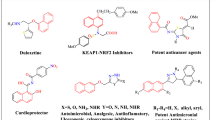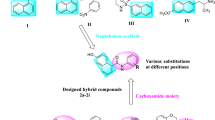Abstract
In this study, a series of 1-phenoxyalkyl-4-[(N,N-disubstitutedamino)alkyl]piperazine derivatives has been prepared and in vitro tested as H3-receptor antagonists (electrically evoked contraction of the guinea pig jejunum). All compounds investigated show moderate in vitro affinities. The most potent antagonists in this series are the compounds 9b, 1b, 1f, and 1l, which exhibit, independently of the substituent at the end of -N- moiety, almost the same level of affinity (pA 2 = 7.18, pA 2 = 7.27, pA 2 = 7.13, pA 2 = 7.12, respectively). The histaminergic H1 antagonism of the aforementioned four products was established on the isolated guinea pig ileum by conventional methods; the pA 2 values were compared with the potency of pyrilamine. None of them shows any H1-antagonistic activity (pA 2 < 4; for pyrilamine pA 2 = 9.35).




Similar content being viewed by others
References
Alves-Rodrigues A, Leurs R, Wu TS, Prel GD, Foged C, Timmerman H (1996) [3H]-thioperamide as a radioligand for the histamine H H3 receptor in rat cerebral cortex. Br J Pharmacol 118:2045–2052
Apodaca R, Dvorac CA, Xiao W, Barbier AJ, Boggs JD, Wilso SJ, Lovenberg TW, Carruthers NI (2003) A new class of diamine-based human histamine H3 receptor antagonists: 4-(aminoalkoxy)benzylamines. J Med Chem 46:3938–3944
Arrang JM, Garbarg M, Schwartz JC (1983) Auto-inhibition of brain histamine release mediated by a novel class (H3) of histamine receptor. Nature 302:832–837
Arrang JM, Garbarg M, Schwartz JC (1985) Autoregulation of histamine release in brain by presynaptic H3-receptors. Neuroscience 15:553–562
Arrang JM, Garbarg M, Schwartz JC (1987) Autoinhibition of histamine synthesis mediated by presynaptic H3-receptors. Neuroscience 23:149–157
Arunlakshana O, Schild HO (1959) Some quantitative uses of drug antagonists. Br J Pharmacol 14:48–58
Banik BK, Becker FF (2001) Polycyclic aromatic compounds as anticancer agents: structure–activity relationships of chrysene and pyrene derivatives. Bioorg Med Chem 9:593–605
Berlin M, Boyce CW, de Lera Ruiz M (2011) Histamine H3 receptor as a drug discovery target. J Med Chem 54:26–53
Capuano B, Crosby IT, Lloyd EJ, Podloucka A, Taylor DA (2008) Synthesis and preliminary pharmacological evaluation of 4’-Arylalkyl analogues of Clozapine. IV. The effects of the aromatic and isosteric replacement. Aust J Chem 61:930–940
Clapham J, Kilpatrick GJ (1992) Histamine H3-receptors modulate the release of [3H]-acetylcholine from slices of rat entorhinal cortex: evidence for the possible existence of H3-receptor subtypes. J Pharmacol 107:919–923
Collins RF, Davis M (1961) The chemotherapy of schistosomiasis. Part IV. Some ethers of 4-amino-2-methoxyphenol. J Chem Soc (May):1863–1879
Cowart M, Faghih R, Curtis MP, Gfesser GA, Bennani YL, Black LA, Pan L, Marsh KC, Sullivan JP, Esbenshade TA, Fox GB, Hancock AA (2005) 4-(2-[2-(2(R)-Methylpyrrolidin-1-yl)ethyl]benzofuran-5-yl)benzonitrile and related 2-aminoethylbenzofuran H3 receptor antagonists potently enhance cognition and attention. J Med Chem 48:38–55
Frymarkiewicz A, Walczyński K (2009) Non-imidazole histamine H3 ligands, part IV: SAR of 1-[2-thiazol-5-yl-(2-aminoethyl)]-4-n-propylpiperazine derivatives. Eur J Med Chem 44:1674–1681
Glase SA, Robertson DW, Wise LD (2002) Attention deficit hyperactivity disorder: Pathophysiology and design of new treatments. Annu Rep Med Chem 37:11–20
Kieć-Kononowicz K, Ligneau X, Stark H, Schwartz JC, Schunack W (1995) Azines and diazines as potential histamine H3-receptor antagonists. Arch Pharm Med Chem 328:445–450
Labella FS, Queen G, Glavin G, Durant G, Stein D, Brandes IJ (1992) H3 receptor antagonist, thioperamide, inhibits adrenal steroidogenesis and histamine binding to adrenocortical microsomes and binds to cytochrome P450. Br J Pharmacol 107:161–164
Lehman MR, Thompson CD, Marvel CS (1933) Quaternary ammonium salts from halogenated alkyl dimethylamines. III. omega-bromo-heptyl-, -octyl-, -nonyl- and -decyl-dimethylamines. J Am Chem Soc 55:1977–1981
Leurs R, Tulup MT, Menge WM, Adolfs MJ, Zuiderveld OP, Timmerman H (1995) Evaluation of receptor selectivity of the H3 receptor antagonists, iodophenpropit and thioperamide: an interaction with the 5-HT3 receptor revealed. Br J Pharmacol 116:2315–2321
Leurs R, Blandina P, Tedford C, Timmerman H (1998) Therapeutic potential of histamine H3 receptor agonists and antagonists. Trends Pharmacol Sci 19:177–183
Leurs R, Bakker RA, Timmerman H, de Esch IJ (2005) The histamine H3 receptor: from gene cloning to H3 receptor drugs. Nat Rev Drug Discov 4:107–120
Ligneau X, Lin J, Vanni-Mercier G, Jouvet M, Muir JL, Ganellin CR, Stark H, Elz S, Schunack W, Schwartz JC (1998) Neurochemical and behavioral effects of ciproxifan, a potent histamine H3-receptor antagonist. J Pharmacol Exp Therap 287:658–666
Ligneau X, Morriset S, Tradivel-Lacombe J, Gbabou F, Ganellin CR, Stark H, Schunack W, Schwartz JC, Arrang JM (2000) Distinct pharmacology of rat and human histamine H3 receptors: role of two amino acids in the third transmembrane domain. Br J Pharmacol 131:1247–1250
Littmann ER, Marvel CS (1930) Cyclic quaternary ammonium salts from halogenated aliphatic tertiary amines. J Am Chem Soc 52:287–294
Liu C, Ma X, Jiang X, Wilson SJ, Hofistra CI, Blevit J, Pyati J, Li XB, Chai WY, Carruthers N, Lovenberg TW (2001) Cloning and pharmacological characterization of a fourth histamine receptor (H4) expressed in bone marrow. Mol Pharmacol 59:420–426
Lovenberg TW, Roland BL, Wilson SJ, Jiang X, Pyati J, Huvar A, Jackson MR, Erlander MG (1999) Accelerated communication: cloning and functional expression of the human histamine H3 receptor. Mol Pharmacol 55:1101–1107
Lovenberg TW, Pyti J, Chang H, Wilson SJ, Erlander MG (2000) Cloning of rat histamine H3 receptor reveals distinct species pharmacological profiles. J Pharmacol Exp Therap 293:771–778
Meier G, Apelt J, Reichert U, Grassman S, Ligneau X, Elz S, Leurguin F, Ganellin CR, Schwartz JC, Schunack W, Stark H (2001) Influence of imidazole replacement in different structural classes of histamine H3-receptor antagonists. Eur J Pharm Sci 13:249–259
Mikò T, Ligneau X, Pertz HH, Arrang JM, Ganellin CR, Schwartz JC, Schunack W, Stark H (2003) Novel nonimidazole histamine h3 receptor antagonists: 1-(4-(phenoxymethyl)benzyl)piperidines and related compounds. J Med Chem 46:1523–1530
Mikò T, Ligneau X, Pertz HH, Arrang JM, Ganellin CR, Schwartz JC, Schunack W, Stark H (2004) Structural variations of 1-(4-(phenoxymethyl)benzyl)piperidines as nonimidazole histamine H3 receptor antagonists. Bioorg Med Chem 12:2727–2736
Schlicker E, Betz R, Göthert M (1988) Histamine H3 receptor-mediated inhibition of serotonin release in the rat brain cortex. Naunyn-Schmideberg’s Arch Pharmacol 337:588–590
Schlicker E, Fink K, Hinterthaner M, Göthert M (1989) Inhibition of noradrenaline release in the rat brain cortex via presynaptic H3 receptors. Naunyn-Schmideberg’s Arch Pharmacol 340:633–638
Schlicker E, Malinowska M, Kathmann M, Göthert M (1994) Modulation of neurotransmitter release histamine H3 heteroreceptors. Fundam Clin Pharmacol 8:128–137
Stark H, Sipll W, Ligneau X, Arrang JM, Ganellin CR, Schwartz JC, Schunack W (2001) Different antagonist binding properties of human and rat histamine H3 receptors. Bioorg Med Chem Lett 11:951–954
Tkaczyński T (1966) Synthesis of ethylene amines N-hydroxyethylpiperazine and N,N-bis-hydroxyethylpiperazine. Acta Pol Pharm 4:355–357
Van der Goot H, Schepers MJ, Sterk GJ, Timmerman H (1992) Isothiourea analogs of histamine as potent agonists or antagonists of the histamine H3-receptor. Eur J Med Chem 27:511–517
Van Es A, Stevens W (1965) Mixed carboxylic acid anhydrides: V. Synthesis of alkyl formates. Recl Trav Chim Pays-Bas 84:704–709
Vohora D, Pal SN, Pillai KK (2001) Histamine and selective H3-receptor ligands: a possible role in the mechanism and management of epilepsy. Pharmacol Biochem Behav 68:735–741
Vollinga RC, Zuiderveld OP, Scheerens H, Bast A, Timmerman H (1992) A simple and rapid in system for the screening of histamine H3-ligands. Methods Find Exp Clin Pharmacol 105:747–751
Walczyński K, Guryn R, Timmerman H, Zuiderveld O (1999a) Non-imidazole histamine H3 ligands. Part I. Synthesis of 2-(1-piperazinyl)- and 2-(hexahydro-1H-1,4-diazepin-1-yl)benzothiazole derivatives as H3-antagonists with H1 blocking activities. Il Farmaco 54:684–694
Walczyński K, Guryn R, Zuiderveld OP, Timmerman H (1999b) Non-imidazole histamine H3 ligands, part 2: new 2-substituted benzothiazoles as histamine H3 antagonists. Arch Pharm Pharm Med Chem 332:389–398
Walczyński K, Zuiderveld OP, Timmerman H (2005) Non-imidazole histamine H3 ligands. Part III. New 4-n-propylpiperazines as non-imidazole histamine H3-antagonists. Eur J Med 40:15–23
Witkin JM, Nelson DL (2004) Selective histamine H3 receptor antagonists for treatment of cognitive deficiencies and other disorders of the central nervous system. Pharmacol Ther 103:1–20
Wulff BS, Hastrup S, Rimvall K (2002) Characteristics of recombinantly expressed rat and human histamine H3 receptors. Eur J Pharmacol 453:33–41
Yoshimatsu H, Itateyama E, Kondou S, Tajima D, Himeno K, Hidaka S, Kurokawa M, Sakata T (1999) Hypothalamic neuronal histamine as a target of leptin in feeding behavior. Diabetes 48:2286–2291
Zaragoza F, Stephensen H, Peschke B, Rimvall K (2005) 2-(4-Alkylpiperazin-1-yl)quinolines as a new class of imidazole-free histamine H3 receptor antagonists. J Med Chem 48:306–311
Author information
Authors and Affiliations
Corresponding author
Rights and permissions
About this article
Cite this article
Staszewski, M., Walczyński, K. 1-Phenoxyalkyl-4-[(N,N-disubstitutedamino)alkyl]piperazine derivatives as non-imidazole histamine H3-antagonists. Med Chem Res 22, 1287–1304 (2013). https://doi.org/10.1007/s00044-012-0090-2
Received:
Accepted:
Published:
Issue Date:
DOI: https://doi.org/10.1007/s00044-012-0090-2




